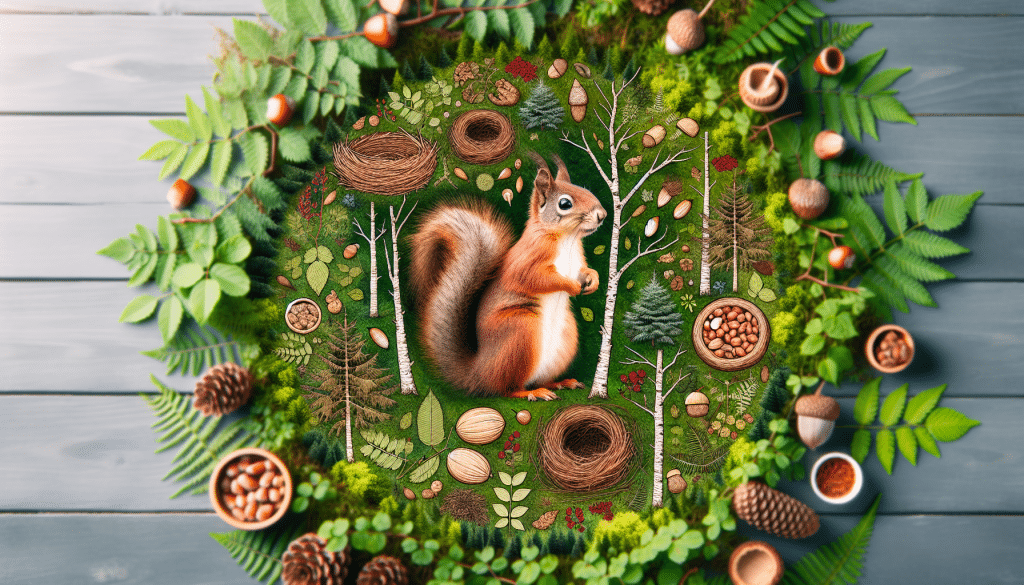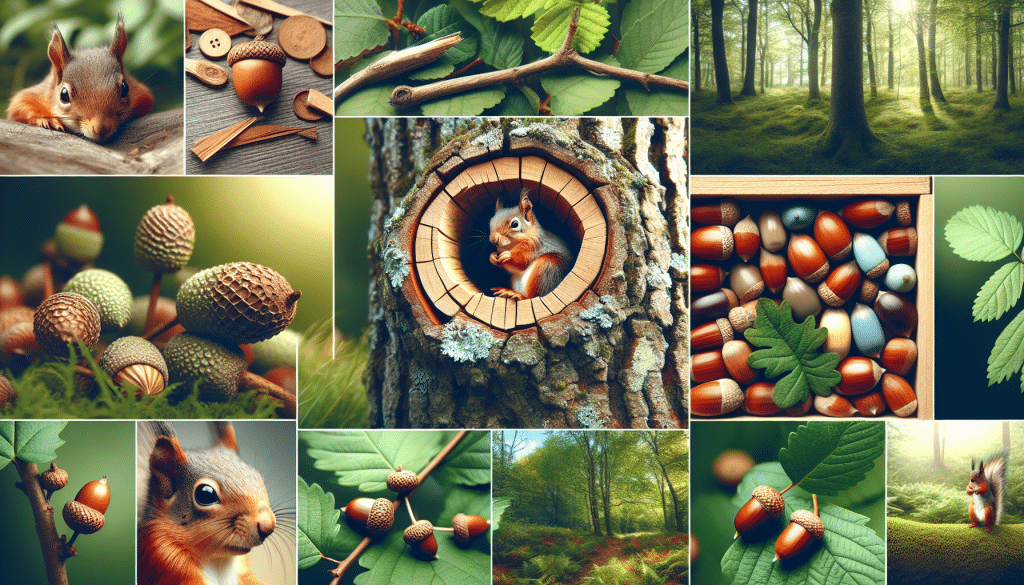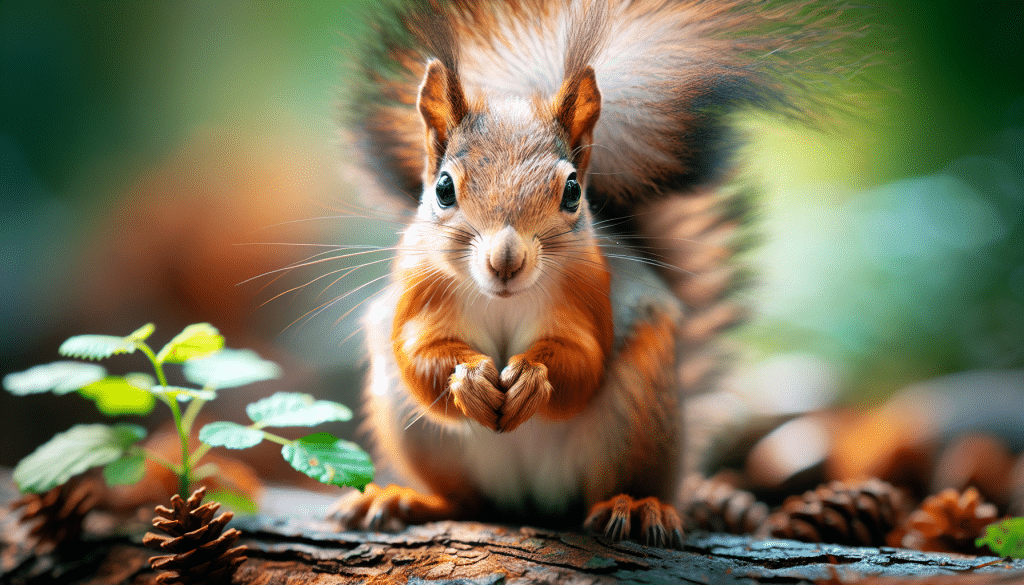If you want squirrels to feel right at home in your backyard, you need to create a suitable habitat for them. A suitable habitat means a place where squirrels can find food, build their nests, and feel safe from predators. By providing trees with plenty of branches, installing feeders filled with nuts and seeds, and adding cozy squirrel houses, you can create a squirrel paradise right in your own yard!

Understanding Squirrel Behavior and Preferences
Squirrels are small, furry creatures that can be found in many parts of the world. They have fascinating behaviors and specific preferences when it comes to their habitat and food choices. By understanding these behaviors and preferences, we can create a suitable habitat that will attract and support squirrels.
Primary Behaviors of Squirrels
Squirrels are known for their excellent climbing skills. They have sharp claws and strong legs that allow them to climb trees and leap from branch to branch. Squirrels are also very agile and quick, which helps them escape from predators.
Another important behavior of squirrels is their habit of hoarding food. They collect and store food during times of plenty to have enough to eat during the colder months when food is scarce. They bury nuts and seeds in the ground or hide them in tree trunks, remembering each hiding spot for later retrieval.
Foods Preferred by Different Squirrel Species
Different species of squirrels have different food preferences. Some species, like the gray squirrel, prefer nuts, acorns, and seeds. Other species, like the red squirrel, have a diet that includes berries, fruits, and even bird eggs. It’s important to provide a variety of food sources to attract a diverse population of squirrels.
Natural Habitat Preferences
Squirrels prefer habitats with plenty of trees and foliage. They feel safest and most comfortable in environments where they can easily navigate among the branches and find shelter. Squirrels also prefer habitats with a good supply of food sources, such as trees that bear nuts or fruits.
The Importance of Trees and Foliage
Trees and foliage play a crucial role in creating a squirrel-friendly habitat. Trees provide food, shelter, and a safe space for squirrels to build their nests. Foliage, such as leaves and branches, offers protection from predators and provides a comfortable environment for squirrels to move around.
The Basics of a Squirrel-Friendly Habitat
To create a suitable habitat for squirrels, certain components and features need to be considered. These elements will provide squirrels with everything they need to survive and thrive in their environment.
Essential Components of a Squirrel Habitat
A squirrel-friendly habitat should include plenty of trees and foliage, as mentioned earlier. Additionally, it’s beneficial to have a variety of plants and shrubs that produce fruits or nuts to serve as a natural food source. Providing a water source such as a birdbath or shallow pond is also essential for squirrels’ hydration needs.
Nesting Requirements
Squirrels build nests called dreys to live in. These dreys are typically made of twigs, leaves, and moss, and are constructed in the branches of trees. Establishing nesting boxes or providing suitable nesting materials like twigs and leaves will encourage squirrels to make their homes in a designated area of the habitat.
Safety Features
Creating a safe environment is crucial for squirrel habitats. This means minimizing potential hazards such as sharp objects or toxic plants. It’s also important to avoid using harmful chemicals or pesticides that could harm squirrels or their food sources. Ensuring there are no accessible routes for predators, like cats or larger birds, will greatly contribute to squirrel safety.
Accessibility for Squirrels
Squirrels need easy access to all the necessary components of their habitat. This means having well-placed trees and shrubs that allow squirrels to climb and move around freely. Consider the layout of the habitat, making sure there are no physical obstructions that could hinder squirrels’ movements.

Selecting the Right Location for a Squirrel Habitat
Finding the perfect location for a squirrel habitat is crucial to its success. The location should provide a suitable environment for squirrels while also considering potential human or predatory threats.
Assessing the Suitability of Your Space
Before setting up a squirrel habitat, it’s important to assess the suitability of your space. Determine if you have enough trees and foliage to meet the habitat’s requirements. Consider the available space and its proximity to human dwellings, as well as factors like local climate and soil conditions.
Proximity to Human Dwellings
While squirrels can coexist with humans, it’s important to strike a balance between their habitat and human activities. Look for a location that is not too close to human dwellings to minimize potential conflicts or disturbances. Squirrels prefer quieter areas where they can feel safe and undisturbed.
Avoiding Predatory Threats
Predators pose a significant threat to squirrels, so it’s important to choose a location that minimizes their presence. Avoid areas with high concentrations of predators, such as larger birds of prey or outdoor cats. This will help ensure the safety and well-being of the squirrels in the habitat.
Considering Local Climate
The local climate plays a significant role in determining the success of a squirrel habitat. Squirrels have different adaptations to different climates, so it’s essential to consider the specific needs of the squirrel species in your area. Ensure that the location provides appropriate shelter and food sources that can withstand the local weather conditions.
Designing the Habitat Layout
Designing the layout of a squirrel habitat involves careful planning to create a space that meets all the needs of the squirrels. Consider the different elements that will make the habitat functional and enjoyable for the squirrels that inhabit it.
Creating Structures for Shelter
To provide shelter for squirrels, consider adding nesting boxes or platforms on trees where squirrels can build their dreys. These structures should be placed in safe locations, away from potential threats and disturbances. Ensure they are sturdy and well-protected from the elements.
Planning for Multiple Feeding Stations
Squirrels need access to food sources throughout their habitat. It’s important to plan for multiple feeding stations, spreading them out to allow more squirrels to feed simultaneously. Use squirrel-proof feeders or place them in areas where squirrels can easily access them but other animals will have difficulty.
Ensuring Space for Play and Exercise
Squirrels are active creatures and need space for play and exercise. Include climbing structures such as tree trunks and branches, along with obstacles like logs or rocks, to encourage squirrels to engage in natural behaviors. This will help keep them healthy and stimulated.
Incorporating Water Sources
Water is essential for squirrels’ hydration and cleanliness. Include water sources such as birdbaths or shallow ponds in your habitat. Ensure that the water is clean and changed regularly to prevent the spread of diseases. Making water sources accessible to squirrels will further enhance the squirrel-friendly environment.

Choosing Plants and Trees Beneficial to Squirrels
The flora in a squirrel habitat plays a vital role in providing food, shelter, and overall sustainability. Consider the types of plants and trees that will best support the needs of squirrels in your habitat.
Native Flora Vs Non-native Plants
When selecting plants for a squirrel habitat, prioritize native flora. Native plants are better adapted to the local environment, providing squirrels with familiar food sources and shelter. Non-native plants may not offer the same level of support for squirrels and could disrupt the ecological balance.
Fruit-bearing Trees for Food Source
Fruit-bearing trees are excellent additions to a squirrel habitat as they provide a natural and nutritious food source. Consider planting trees such as apple, cherry, or walnut, which produce fruits that squirrels enjoy. Ensure the trees are well-maintained to ensure a consistent food supply for the squirrels.
Leafy Trees and Shrubs for Shelter
Leafy trees and shrubs are essential for providing shelter and cover in a squirrel habitat. Plant trees like oak, maple, or pine, which have dense foliage that can protect squirrels from both predators and harsh weather conditions. Shrubs and bushes can also provide additional hiding spots and protection.
Safe and Toxic Plants for Squirrels
It’s important to be aware of toxic plants that could be harmful to squirrels. Some common plants, such as azaleas, rhododendrons, or lilies, can be poisonous to squirrels if ingested. Research and choose plants that are safe for squirrels, ensuring a healthy and hazard-free habitat.
Building Squirrel Nests and Dreys
Building squirrel nests, known as dreys, is essential to create a habitat that offers shelter and a safe space for squirrels to raise their young. Consider the materials, placement, and maintenance necessary for successful nest construction.
Materials Needed for Constructing Drey
Squirrels typically construct dreys using materials like twigs, leaves, and moss. Collect these materials and provide them in designated areas of the habitat to encourage squirrels to build their nests. Consider adding shredded paper or other soft materials for added comfort.
Safety Considerations When Placing Nests
When placing squirrel nests in the habitat, it’s important to prioritize safety. Choose secure locations in the branches of trees, away from potential predators and disturbances. Ensure the nests are stable and well-built, with no risk of collapsing or falling.
Squirrel Nest Maintenance
Regular maintenance of squirrel nests is important to ensure their longevity and usability. Check the nests periodically for damage or signs of deterioration. If necessary, provide additional materials for repairs or encourage squirrels to build new nests.
Alternatives to Natural Nesting: Squirrel Boxes
If natural nesting sites are scarce in your habitat, you can provide alternative nesting options for squirrels, such as squirrel boxes or nesting houses. These structures mimic natural dreys and provide a safe place for squirrels to raise their young. Place them at a suitable height and away from potential threats.
Feeding Station Essentials
Feeding stations are crucial in a squirrel habitat, providing a reliable food source for the squirrels and encouraging them to stay in the area. Consider the types of feeders and food, as well as the location and maintenance of the feeding areas.
Types of Feeders and Food
There are various types of feeders that you can use in a squirrel habitat. Traditional bird feeders with squirrel baffles can be employed to provide nuts, seeds, or fruits. Specially designed squirrel feeders that require the squirrels to work for their food can also be used.
Location and Protection of Feeders
When placing feeders, choose locations that are easily accessible to squirrels but make it more challenging for other animals to access the food. Consider using squirrel-proof feeders or strategically positioning feeders near trees or structures that squirrels can climb.
Maintaining Cleanliness Around Feed Areas
Regularly clean and maintain the feeding areas to prevent the spread of diseases or attracting unwanted pests. Remove any spilled food, clean feeders regularly, and ensure that the area around the feeders is free of debris and waste.
Seasonal Feeding Adjustments
Adjust the feeding habits and offerings based on the seasons. Squirrels may have different dietary needs during different times of the year. In colder months, provide food with higher energy content to help squirrels sustain themselves through the winter.
Integrating Play and Exercise Features
Squirrels are active animals that require opportunities for play and exercise. Incorporating play and exercise features in the habitat will help keep squirrels healthy and mentally stimulated.
Obstacle Courses and Squirrel-Proofing
Design obstacle courses or use natural elements like logs, branches, or rocks to create challenges for squirrels. These obstacles will encourage squirrels to use their natural agility and problem-solving skills while providing them with an outlet for their playful instincts. Ensure that any obstacles or structures are safe and squirrel-friendly.
Providing Climbing Structures
Squirrels love to climb, so incorporating climbing structures into the habitat is essential. Trees with different levels of branches, tree trunks, or even artificial structures like cat trees or climbing walls can provide opportunities for squirrels to engage in their natural climbing behaviors.
Interactive Elements to Encourage Activity
To further encourage activity, include interactive elements in the habitat. This can include toys or puzzles that squirrels can interact with to obtain treats or food. These interactive elements stimulate squirrels’ curiosity and intelligence, keeping them mentally engaged and entertained.
Safe Materials for Squirrel Toys
When selecting toys or materials for squirrel enrichment, prioritize safety. Avoid toys that contain small parts that could be swallowed or pose a choking hazard. Stick with natural materials like wood, rope, or food-grade plastic to ensure the health and well-being of the squirrels.
Water Sources and Their Importance
Water is a vital component of a squirrel-friendly habitat. Providing access to clean water sources is essential for squirrels’ hydration and can help attract and support a healthy squirrel population.
Methods for Providing Water
There are various methods for providing water in a squirrel habitat. Birdbaths or shallow ponds can be used, ensuring that they are easily accessible to squirrels. Consider adding small rocks or stones for squirrels to use as stepping stones or platforms in the water source.
Keeping Water Sources Clean and Safe
Regularly clean and monitor water sources to prevent the buildup of algae or debris. Change the water frequently to ensure it remains clean and fresh. Keep the water levels shallow to avoid any drowning risks for squirrels.
Winterizing Water Features
During colder months, it is essential to winterize water features to ensure they do not freeze over completely. Consider adding a small heating element or placing floating objects in the water to prevent freezing. This will ensure squirrels have access to water even during freezing temperatures.
Avoiding Stagnant Water to Prevent Diseases
Stagnant water can become a breeding ground for harmful bacteria and parasites. Avoid using standing water sources that can become stagnant. Instead, opt for moving water options like small fountains or drip systems, which not only prevent stagnation but also provide a more enticing water source for squirrels.
Legal Considerations and Wildlife Regulations
Before creating a squirrel habitat, it’s important to be aware of local laws and regulations regarding wildlife care. Understanding and complying with these guidelines ensures the responsible management of the squirrel habitat.
Understanding Local Laws on Wildlife Care
Research and familiarize yourself with your local laws and regulations regarding the care and management of wildlife, including squirrels. Different regions may have specific requirements or conditions for creating a squirrel habitat, so ensure you are aware of your responsibilities as a habitat owner.
Obtaining Necessary Permits if Required
Depending on your location, you may need to obtain permits or licenses to legally create and maintain a squirrel habitat. Contact your local wildlife authorities or conservation agencies to inquire about any necessary permits or approvals needed. Adhering to these legal requirements ensures the proper management and protection of the habitat.
Responsible Rehabilitation of Injured Squirrels
If you come across an injured squirrel or find an orphaned baby squirrel, it’s important to handle the situation responsibly. Consult with local wildlife rehabilitation organizations or authorities to seek guidance on how to provide proper care or find suitable rehabilitation centers.
Ensuring Compliance with Conservation Efforts
Conservation efforts are critical for the preservation and protection of wildlife, including squirrels. Ensure that your squirrel habitat aligns with conservation efforts by promoting sustainable practices, protecting natural habitats, and respecting the natural behaviors and needs of the squirrels.
In conclusion, creating a suitable habitat for squirrels involves understanding their behaviors and preferences, considering their needs for food, shelter, and exercise, and selecting appropriate plants and trees. By following the guidelines and recommendations outlined in this article, you can create a habitat that will attract and support a thriving squirrel population while ensuring their safety and well-being.


